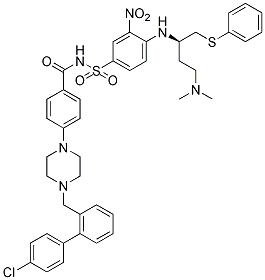ABT-737
| CAS No. | 852808-04-9 | Cat. No. | BCP01725 |
| Name | ABT-737 | ||
| Synonyms | ABT737;ABT 737; | ||
| Formula | C42H45ClN6O5S2 | M. Wt | 813.43 |
| Description | ABT-737 shows low activity to Bcl-B and no effects to Mcl-1 and BFL-1. ABT-737 is sensitive to HL60, KG1 and NB4 cells with IC50 of 50 nM, 80 nM and 80 nM, respectively. ABT-737 induces apoptosis in HL60 cells, which due to decreased Bcl-2/Bax heterodimerization and has no effect on cell cycle distribution. ABT-737 also induces cytochrome c release from purified mitochondria and promotes conformational changes in Bax that are associated with apoptosis. Resistant cells (Hela and MCF-7) can be sensitized to ABT-737 by approaches that down-regulate, destabilize, or inactivate Mcl-1. ABT-737 also causes Bax/BAK-dependent cytochrome c release only when Mcl-1 has been neutralized. ABT-737 displaces Bim from Bcl2's BH3-binding pocket, allowing Bim to activate Bax, induce mitochondrial permeabilization, and rapidly commit the primary chronic lymphocytic leukemia (CLL) cells to death. Knockdown of Mcl-1 with siRNA sensitizes two resistant SCLC cell lines H196 and DMS114 to ABT-737 by enhancing | ||
| Pathways | Apoptosis Pathway | ||
| Targets | Bcl2 | ||
|
ABT-737 Induces Bim Expression via JNK Signaling Pathway and Its Effect on the Radiation Sensitivity of HeLa Cells
Publications Citing of Biochempartner's ABT-737(CAS:852808-04-9) |
|
Norcantharidin combined with ABT-737 for hepatocellular carcinoma: Therapeutic effects and molecular mechanisms
Publications Citing of Biochempartner's ABT-737(CAS:852808-04-9) |
Structure

Part data of this page collected from the open network resources, so Biochempartner can not guarantee its accuracy.
For product details of different batches, please contact our Customer
- Service & Tech Support:orders@biochempartner.com
- Website:www.biochempartner.com
Products are for research use only and not for human use. We do not sell to patients.
